You’ll discover that choosing the right native plants for Western Colorado isn’t as simple as picking what looks pretty at the nursery. Your garden sits at elevations between 4,000 and 10,000 feet, where temperatures can swing forty degrees in a single day and summer droughts stretch for months. These extreme conditions demand plants that have spent thousands of years adapting to thin air, intense UV radiation, and unpredictable weather patterns—but there’s a specific strategy for matching each species to your exact location.
Contents
- 1 Western Colorado’s Unique Environment
- 2 Best Wildflowers for Gardens
- 3 Altitude-Adapted Trees for Western Colorado
- 4 Wildlife-Supporting Shrubs for Gardens
- 5 Selecting the Right Native Plants for Your Garden
- 6 Frequently Asked Questions
- 6.1 When Is the Best Time to Plant Native Species in Western Colorado?
- 6.2 How Much Do Native Rocky Mountain Plants Typically Cost?
- 6.3 Where Can I Purchase Native Plant Seeds in Western Colorado?
- 6.4 Do Native Plants Require Special Fertilizers or Soil Amendments?
- 6.5 How Long Do Native Plants Take to Establish in Garden Settings?
Western Colorado’s Unique Environment
Western Colorado’s landscape creates a climate puzzle that’s both fascinating and challenging for gardeners. You’ll face extreme temperature swings, from -60°F winter lows to summer highs reaching 70°F in mountain peaks. The region’s warming trend, about 2 degrees since 1900, affects traditional growing patterns.
Your elevation determines everything here. Higher altitudes mean cooler temperatures year-round, while mountain corridors enjoy milder conditions than exposed plains. Understanding these native habitats helps you choose plants wisely.
Successful climate adaptation requires recognizing moisture patterns too. Western areas receive monsoon rains July through September, but you’re currently experiencing drought conditions and early snowmelt affecting 2025 growing seasons. The region benefits from Chinook winds that can rapidly increase temperatures by 25 to 35°F, moderating harsh winter conditions in foothill areas.
Best Wildflowers for Gardens
Western Colorado’s native wildflowers offer stunning visual appeal while supporting local ecosystems. Consider showiness, pollinator value, drought tolerance, bloom timing, and landscape adaptability when selecting species. These hardy wildflower varieties thrive in Zone 2 through Zone 6 conditions, making them ideal for the challenging mountain climate.
Colorado Blue Columbine
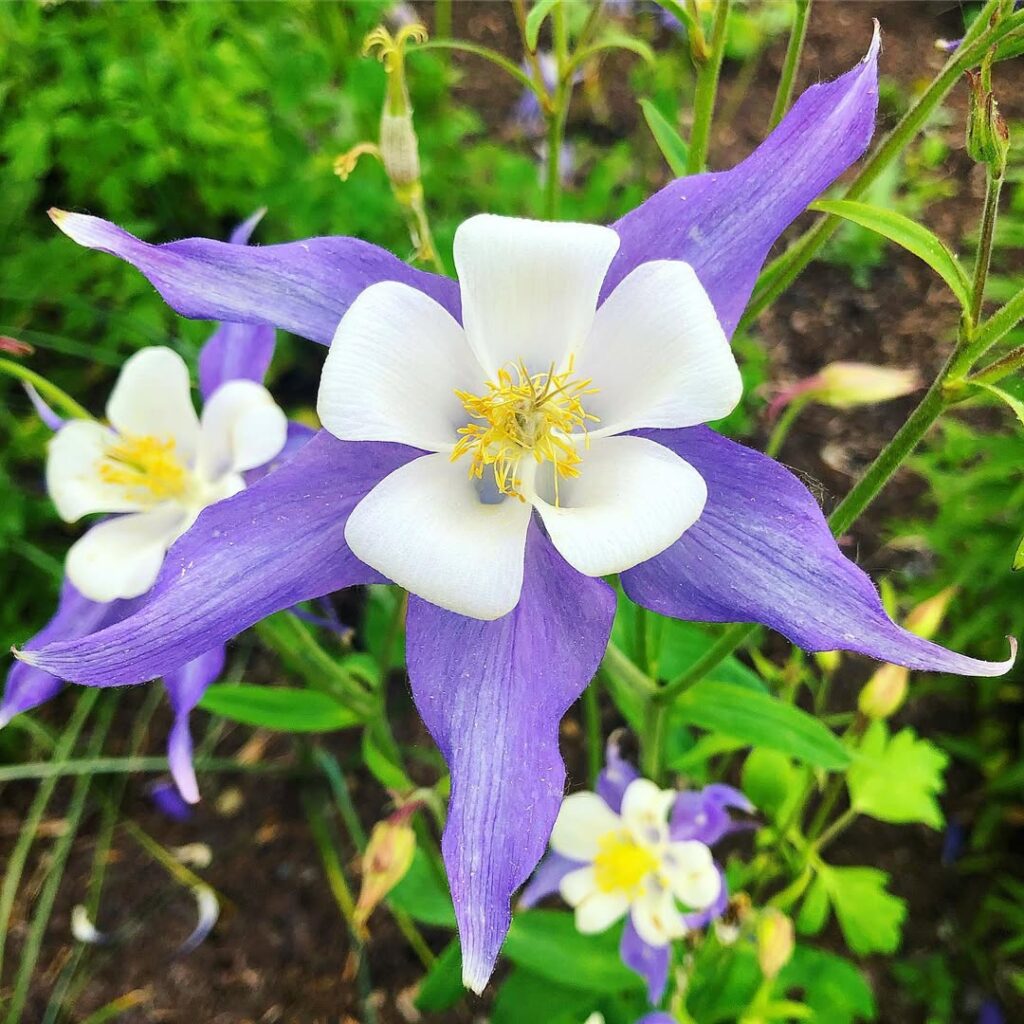
The Colorado Blue Columbine is Colorado’s state flower and one of the most beloved wildflowers in the Rocky Mountain region. This stunning perennial herb produces distinctive flowers with blue sepals and white petals, along with characteristic long spurs that make it easily recognizable. Growing 6-35 inches tall, it thrives in the state’s alpine and subalpine environments.
Native to elevations between 6,000-12,000 feet, the Colorado Blue Columbine naturally occurs in aspen groves, open woodlands, and mountain meadows throughout the Rocky Mountains. It blooms from late spring through mid-summer, creating spectacular displays in its natural habitat and making it an excellent choice for western Colorado gardens that can replicate its preferred growing conditions. The flowers are pollinated by bees, making this native plant an excellent choice for supporting local pollinators.
- Hardiness: Extremely cold hardy, adapted to alpine and subalpine climates
- Light: Partial shade to full sun, prefers some shade in hot conditions
- Water: Consistent moisture preferred, 15-30 inches annual precipitation, drought tolerant once established
- Soil: Well-drained sandy or loamy soils, pH 6.0-7.0
- Fertilizer: Low fertility requirements, adapted to natural mountain soils
- Pest/Disease Resistance: Generally good resistance in appropriate conditions
- Growth Rate: Moderate, perennial herb reaching maturity in 2-3 years
Indian Paintbrush
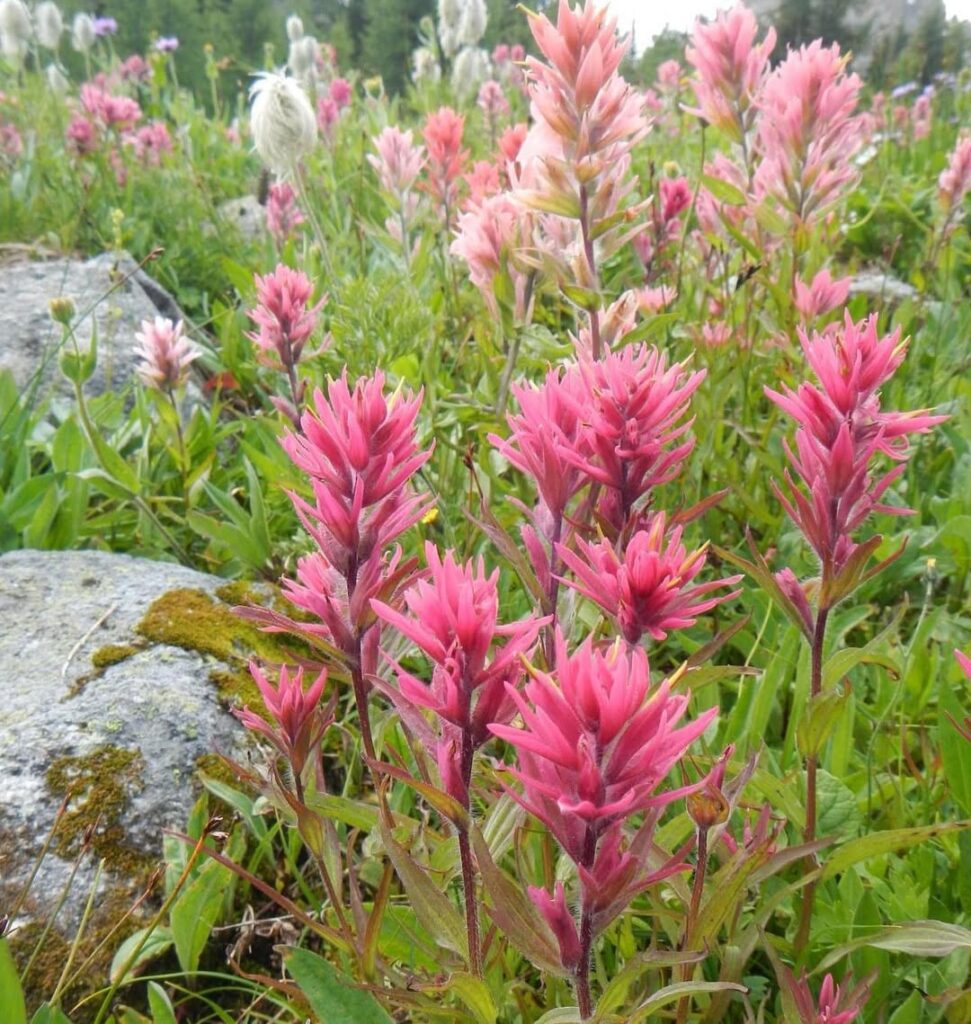
Indian Paintbrush is a striking wildflower that adds brilliant splashes of red, orange, or yellow to western Colorado gardens. What appears to be colorful flowers are actually modified leaves called bracts that resemble a paintbrush dipped in paint. With over 200 native varieties across the western United States, this distinctive plant belongs to the genus Castilleja, named after Spanish botanist Domingo Castillejo.
This hemiparasitic plant has unique growing requirements, as it must attach to host plants’ root systems to obtain nutrients while still performing photosynthesis. Indian Paintbrush serves important ecological functions, supporting Chalcedon, Edith’s, and Theona Checkerspot butterflies as a larval host plant. The plant’s parasitic relationship can actually increase species diversity in plant communities by reducing the competitive advantage of host plants and allowing weaker competitors to thrive. Historically consumed by native tribes, this wildflower makes an excellent addition to native plant gardens within its natural range.
- Hardiness: Zones 3-8, varies by species
- Light: Full sun to partial shade
- Water: Low to moderate, drought tolerant once established
- Soil: Well-draining, sandy or rocky soil preferred
- Fertilizer: None required, obtains nutrients from host plants
- Pest/Disease Resistance: Generally resistant when grown with appropriate hosts
- Growth Rate: Slow to moderate, dependent on host plant establishment
Wild Bergamot

Wild Bergamot is an outstanding native wildflower perfectly suited for western Colorado gardens. This fragrant herbaceous perennial produces clusters of lavender-pink flowers from summer through early fall, attracting native bees, butterflies, and hummingbirds. Growing 18-36 inches tall with aromatic, toothed foliage, it spreads naturally through rhizomes to form attractive clumps.
Highly valued for xeriscaping and waterwise gardens, Wild Bergamot thrives in Colorado’s challenging climate while providing essential pollinator habitat. Its drought tolerance, deer resistance, and adaptability to various soil conditions make it an ideal choice for naturalizing in perennial borders, meadow plantings, or as cut flowers. The dried seed heads provide winter interest and serve as food for goldfinches and field sparrows.
- Hardiness: USDA Zones 4-8, excellent for western Colorado elevations
- Light: Full sun to partial shade
- Water: Low to moderate; drought-tolerant once established
- Soil: Well-drained, adaptable to acidic, neutral, or alkaline; sand, loam, or clay
- Fertilizer: Little to none required; thrives in average soils
- Pest/Disease Resistance: Deer and rabbit resistant; may develop powdery mildew without good air circulation
- Growth Rate: Moderate; spreads via rhizomes to form clumps
Rocky Mountain Penstemon
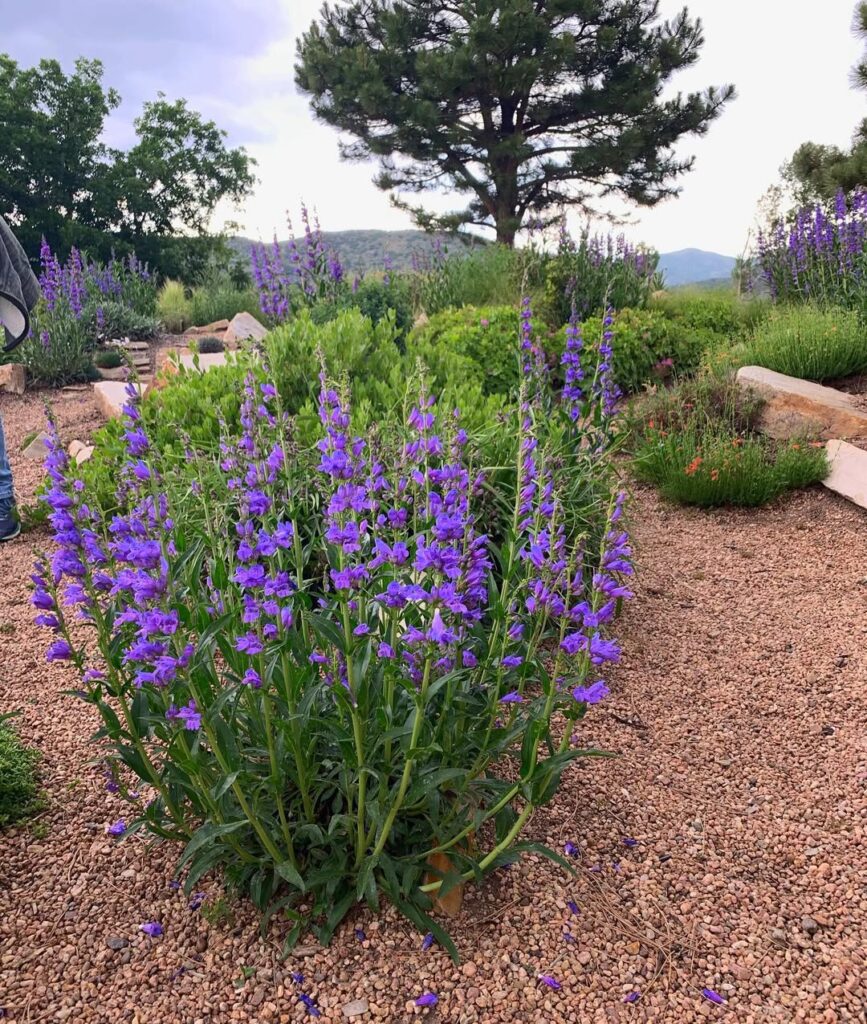
Rocky Mountain Penstemon is a striking evergreen perennial that produces dramatic spikes of deep blue to purple tubular flowers from May through August. Growing 1-3 feet tall from a woody base, this native wildflower features distinctive blooms with curved white stamens protruding from the throat, resembling a beardtongue. The plant forms attractive clumps of dark green basal foliage that provide year-round interest.
This hardy penstemon is one of the easiest varieties to grow in western gardens, thriving in challenging conditions where many plants struggle. It attracts hummingbirds and native bees while remaining deer and rabbit resistant. Perfect for rock gardens, xeriscaping, and native plant landscapes, it naturalizes readily and provides excellent erosion control on slopes. The plant spreads through underground stolons to establish expansive colonies over time.
- Hardiness: USDA Zones 4-9
- Light: Full sun
- Water: Low water requirements; drought tolerant once established
- Soil: Well-drained, sandy or rocky soils preferred; tolerates heavy soils better than other penstemons
- Fertilizer: None required; adapts to ordinary soil conditions
- Pest/Disease Resistance: Excellent; deer and rabbit resistant
- Growth Rate: Moderate; long-lived perennial that naturalizes
Blanket Flower
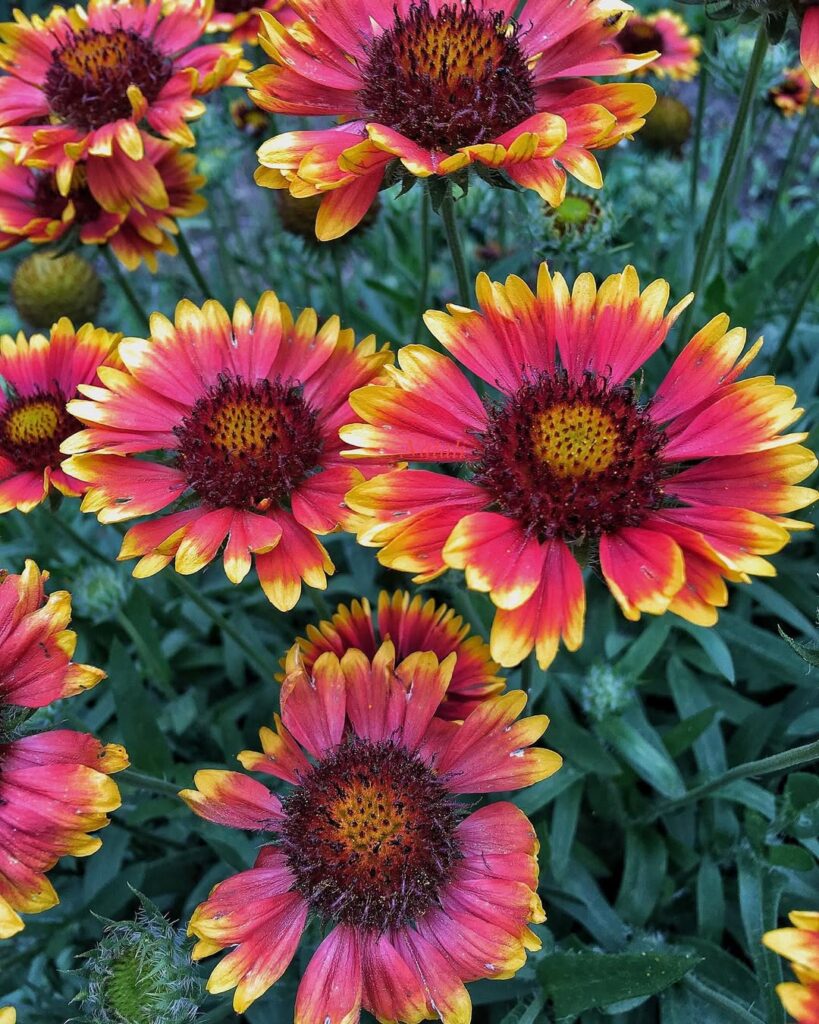
Blanket Flower is a showy native wildflower perfect for Western Colorado gardens. This daisy-like perennial produces vibrant yellow-orange blooms with dark red centers from June through September. Popular cultivars like ‘Arizona Sun’ feature mahogany-red petals with bright yellow edges, while ‘Mesa Red’ displays intense red blooms. Growing 1-3 feet tall with densely hairy stems and leaves, Blanket Flower thrives in challenging conditions and provides excellent drought tolerance once established.
The plant excels in rock gardens, borders, and containers, attracting butterflies and bees while offering outstanding cut flowers. Its long blooming season and ability to naturalize make it invaluable for xeriscaping and native plant gardens, where it provides both visual impact and wildlife habitat. Goldfinches are particularly drawn to the mature seed heads when flowers are allowed to go to seed.
- Hardiness: USDA Zones 3-9
- Light: Full sun
- Water: Moderate to dry; drought tolerant once established
- Soil: Well-drained; tolerates poor, sandy, loamy, or silty soils; avoid poorly drained clay
- Fertilizer: Low requirements; thrives in poor soils
- Pest/Disease Resistance: Deer resistant; good overall disease resistance
- Growth Rate: Moderate; reaches mature size of 1-3 feet tall and 2 feet wide
Altitude-Adapted Trees for Western Colorado
Western Colorado’s diverse elevations demand careful tree selection. The following sections explore high-altitude specialists, drought-resistant species, wildlife benefits, growth characteristics, and landscape suitability considerations. For optimal establishment and survival, trees should be planted during early spring when soil becomes workable and conditions are most favorable for root development.
Quaking Aspen
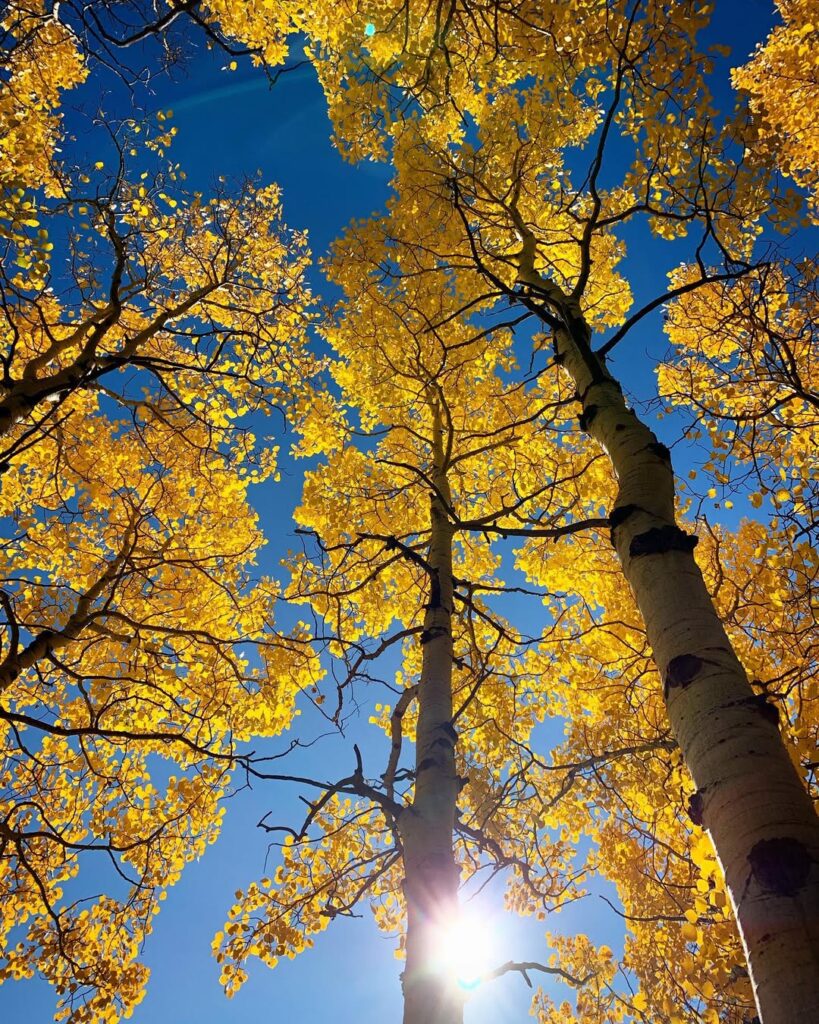
Quaking Aspen is Colorado’s most iconic native deciduous tree, perfectly adapted to Western Colorado’s high-altitude conditions. Thriving at elevations between 6,500-11,500 feet, this pioneer species forms vast clonal colonies through root suckers, creating genetically identical groves that can span hundreds of acres. The distinctive white bark provides significant photosynthetic capacity, while flattened leaf stems create the characteristic “quaking” motion.
These fast-growing trees serve as vital ecological pioneers, quickly colonizing disturbed sites and supporting diverse understory plant communities. Their open canopies allow abundant sunlight to reach the forest floor, fostering rich biodiversity. As Colorado’s only widespread native deciduous tree, aspens provide essential wildlife habitat while creating stunning autumn displays that define the Rocky Mountain landscape. Aspen forests cover an impressive 5 million acres, representing 20% of Colorado’s total forested land.
- Hardiness: USDA zones 1-6, extremely cold tolerant to -50°F
- Light: Full sun to partial shade, prefers open exposures
- Water: Moderate to high moisture needs, adapts to both dry grasslands and wet meadows
- Soil: Sandy and gravelly soils preferred, tolerates both well-drained and poorly drained conditions
- Fertilizer: None required, adapted to nutrient-poor mountain soils
- Pest/Disease Resistance: Generally resistant, some susceptibility to cankers and leaf diseases
- Growth Rate: Fast-growing pioneer species, short-lived but rapidly regenerating
Engelmann Spruce
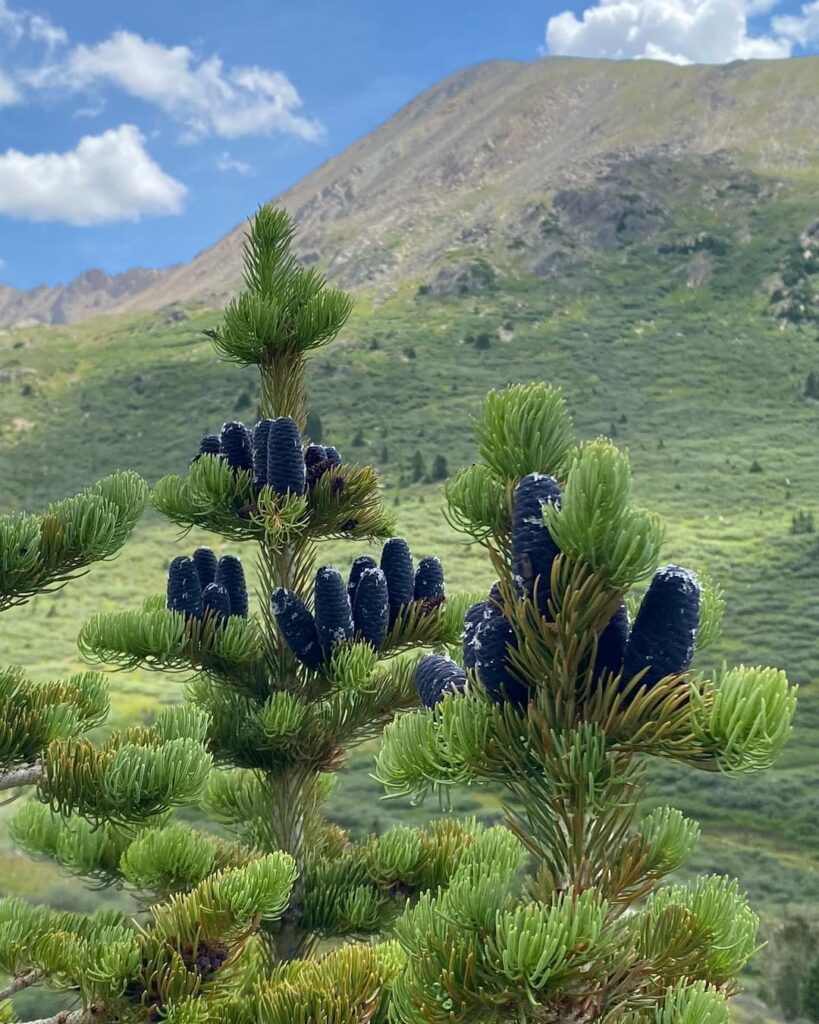
Engelmann spruce is a majestic high-elevation conifer that dominates Colorado’s subalpine forests from 9,300 to 11,000 feet. This slow-growing evergreen develops a distinctive narrow, spire-like form reaching 70-100 feet tall with blue-green, four-sided needles. Perfectly adapted to harsh mountain conditions, it thrives in the moisture-rich environments near treeline and forms extensive forests across nearly 10 million acres of the southern Rocky Mountains.
Known for its exceptional cold tolerance and pest resistance, Engelmann spruce serves as both an ecological cornerstone and valuable landscape specimen. Its dense root system provides vital slope stability while supporting diverse wildlife in subalpine ecosystems. The species’ longevity of up to 300 years and low maintenance requirements make it an excellent choice for mountain properties seeking durable, native evergreen specimens. The tree’s natural beauty and conical shape make it particularly effective as a focal point in landscape design around mountain homes.
- Hardiness: USDA zones 2-6, extremely cold tolerant
- Light: Full sun to partial shade, highly adaptable
- Water: High moisture requirements, thrives with consistent water availability
- Soil: Deep, rich, loamy soils with good drainage
- Fertilizer: Low requirements once established, benefits from organic matter
- Pest/Disease Resistance: Excellent resistance compared to other regional conifers
- Growth Rate: Slow, with potential 300-year lifespan
Douglas Fir
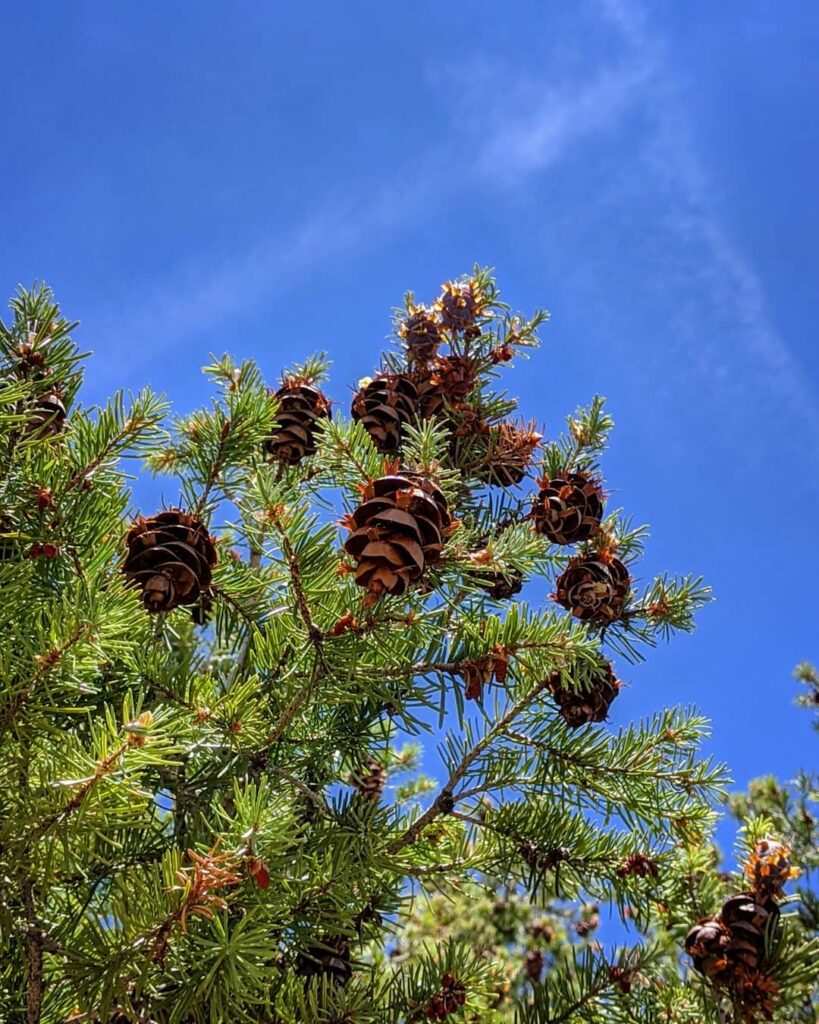
Rocky Mountain Douglas Fir (Pseudotsuga menziesii var. glauca) is a resilient coniferous tree perfectly adapted to Western Colorado’s mountainous terrain and continental climate. This variety evolved specifically to withstand temperature extremes and drought conditions, thriving at elevations between 6,000-9,500 feet throughout the region.
In Western Colorado, Douglas fir typically establishes on northerly exposures and can reach heights of 45-130 feet. The species demonstrates remarkable adaptability, forming diverse plant communities with mountain snowberry, Gambel oak, and quaking aspen while serving as a cornerstone species in subalpine forest ecosystems. The Cascade Mountains create genetic differences in Douglas fir populations, with the Rocky Mountain variety being more drought-tolerant than its coastal counterpart.
- Hardiness: Zones 3-6, extremely cold tolerant with excellent drought resistance
- Light: Full sun to partial shade, thrives on sunny slopes at higher elevations
- Water: Low to moderate water needs once established, drought tolerant
- Soil: Well-draining soils, thrives in glacial till and rocky exposures, pH adaptable
- Fertilizer: Generally unnecessary, adapted to nutrient-poor mountain soils
- Pest/Disease Resistance: Good overall resistance, hardy against mountain climate stresses
- Growth Rate: Moderate to slow, 1-2 feet per year depending on elevation and conditions
Limber Pine
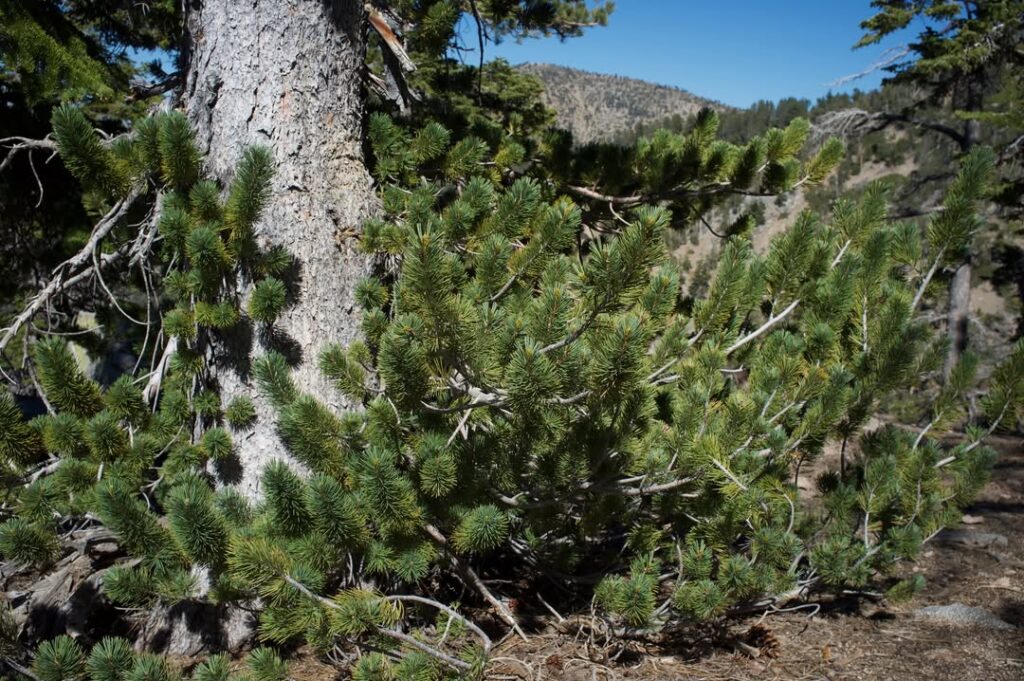
Limber Pine is a remarkable high-elevation conifer native to the Rocky Mountains, perfectly suited for Western Colorado’s harsh mountain environments. This slow-growing evergreen thrives where few other trees can survive, tolerating extreme winds, drought, and poor soils at elevations up to 12,000 feet. Its flexible “limber” branches resist wind damage, while its deep blue-green needles in clusters of five create an attractive evergreen canopy.
Despite challenging growing conditions, Limber Pine can live over 1,000 years and reach 15-35 feet in height. It produces distinctive light brown cones and often displays a twisted, windswept form that adds character to high-elevation landscapes. The cones fall intact to the ground, making identification easier for hikers and naturalists. This hardy pioneer species stabilizes rocky slopes and provides essential habitat for mountain wildlife.
- Hardiness: USDA zones 4-7, extremely cold tolerant to -30°F or lower
- Light: Full sun to partial sun, tolerates intense high-altitude UV exposure
- Water: Low to very low water needs once established, highly drought tolerant
- Soil: Poor, rocky, well-draining soils preferred; tolerates thin, stony, alkaline conditions
- Fertilizer: None required, adapted to nutrient-poor mountain soils
- Pest/Disease Resistance: Excellent resistance due to harsh growing conditions and isolation
- Growth Rate: Very slow, typically 6-12 inches per year
Ponderosa Pine
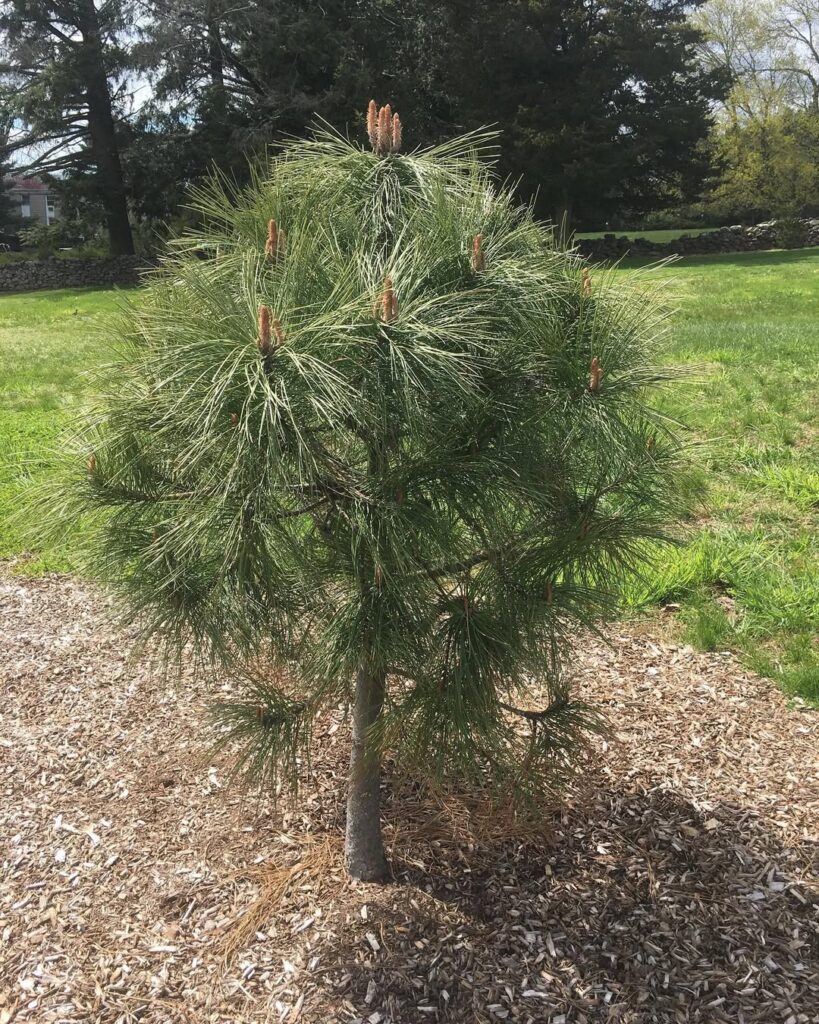
Ponderosa Pine is Colorado’s iconic native conifer, thriving at elevations of 6,000-9,500 feet throughout the foothills and lower montane zones. This drought-tolerant species develops distinctive cinnamon-colored bark and can reach 60-130 feet tall, living up to 500 years with proper conditions.
The species is exceptionally well-adapted to Western Colorado’s challenging climate, featuring deep taproots that access subsurface moisture and thick bark that provides fire resistance. Ponderosa Pine creates park-like forest environments with open canopies, supporting diverse understory vegetation and providing critical wildlife habitat while requiring minimal water once established. These forests occupy approximately 2 million acres in Colorado, representing a significant portion of the state’s forested landscape.
- Hardiness: USDA zones 3-7, adapted to elevations 6,000-9,500 feet
- Light: Full sun, thrives in exposed locations
- Water: Low to moderate; drought-tolerant once established with deep taproot system
- Soil: Well-drained soils essential; tolerates various soil types but not compacted or waterlogged conditions
- Fertilizer: None required; adapted to nutrient-poor mountain soils
- Pest/Disease Resistance: Generally resistant when grown in appropriate conditions; susceptible to bark beetles under stress
- Growth Rate: Slow to moderate, particularly in arid locations
Wildlife-Supporting Shrubs for Gardens
Native shrubs transform Colorado gardens into wildlife havens, providing essential food sources, nesting sites, and year-round habitat while supporting local biodiversity through careful plant selection. These adaptable plants reduce the need for external inputs like frequent watering and fertilizing when properly placed in suitable growing conditions.
Serviceberry
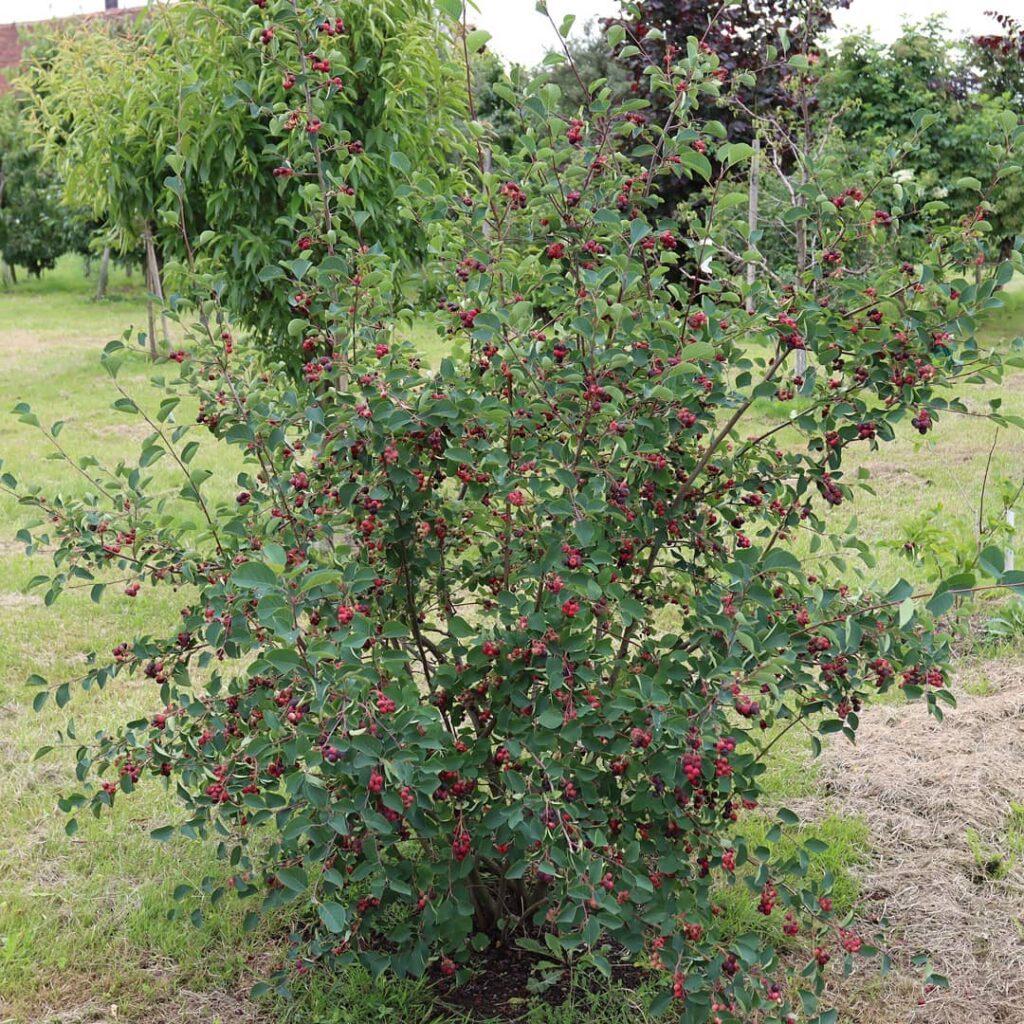
Serviceberry is an exceptional native shrub that serves as a cornerstone species for wildlife-supporting gardens in Western Colorado. This versatile plant produces clusters of fragrant white flowers in early spring, providing essential nectar for pollinators when few other plants are blooming. The subsequent purplish-red to black berries offer sustained nutrition for birds and mammals throughout summer, while the shrub’s dense branching structure creates valuable nesting sites and protective cover.
Growing 4-15 feet tall with attractive coarsely-toothed leaves, serviceberry naturally forms colonies through underground rhizomes, making it ideal for naturalized plantings and habitat restoration projects. Its adaptability to various soil types and elevation ranges up to 8,000 feet, combined with moderate drought tolerance, makes it perfectly suited to Colorado’s challenging growing conditions. The shrub displays beautiful fall color ranging from orange to red, extending its ornamental value well into autumn.
- Hardiness: USDA zones 4-9
- Light: Full sun to partial shade
- Water: Low to moderate; drought tolerant once established
- Soil: Well-draining; tolerates sandy loams to coarse sands
- Fertilizer: Generally not required; benefits from mycorrhizal associations
- Pest/Disease Resistance: Excellent; naturally resistant to most issues
- Growth Rate: Fast-growing with low maintenance requirements
Chokecherry
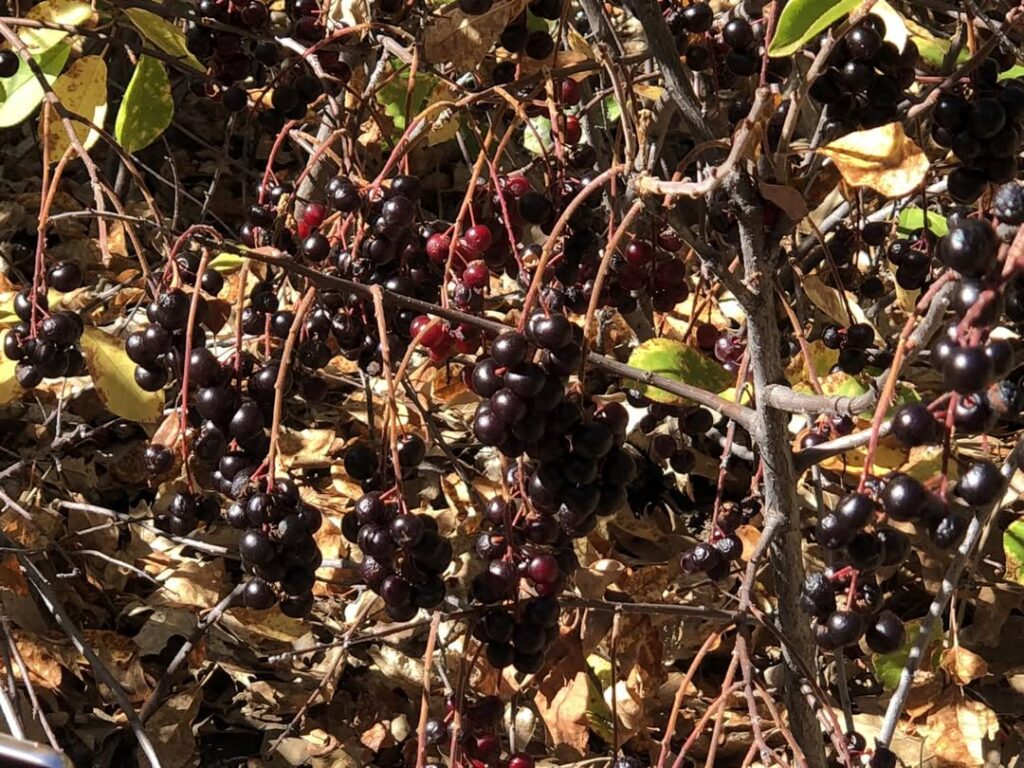
Chokecherry is a versatile multi-stemmed shrub or small tree that serves as an exceptional wildlife magnet in western Colorado gardens. Growing 20-30 feet tall and wide, this native species produces clusters of white spring flowers followed by dark purple berries that feed numerous bird species, mammals, and other wildlife. Its suckering habit creates dense thickets that provide vital nesting sites and shelter.
Beyond its wildlife value, chokecherry offers significant benefits to pollinators through its early nectar sources and acts as a pioneering species that improves soil quality. As a keystone species, chokecherry supports an impressive 340 caterpillar species, making it invaluable for local ecosystem health. The antioxidant-rich berries can be processed into jams and jellies, though proper preparation is essential due to toxins in seeds and leaves.
- Hardiness: Extremely hardy, adapted to western North America climates including Colorado
- Light: Full sun preferred, tolerates partial shade
- Water: Drought tolerant once established, adaptable to various moisture levels
- Soil: Adaptable to wide range of soil types and conditions
- Fertilizer: Low maintenance, typically requires no supplemental fertilization
- Pest/Disease Resistance: Minimal pest issues, naturally resistant
- Growth Rate: Moderate growth rate with suckering habit for thicket formation
Gambel Oak
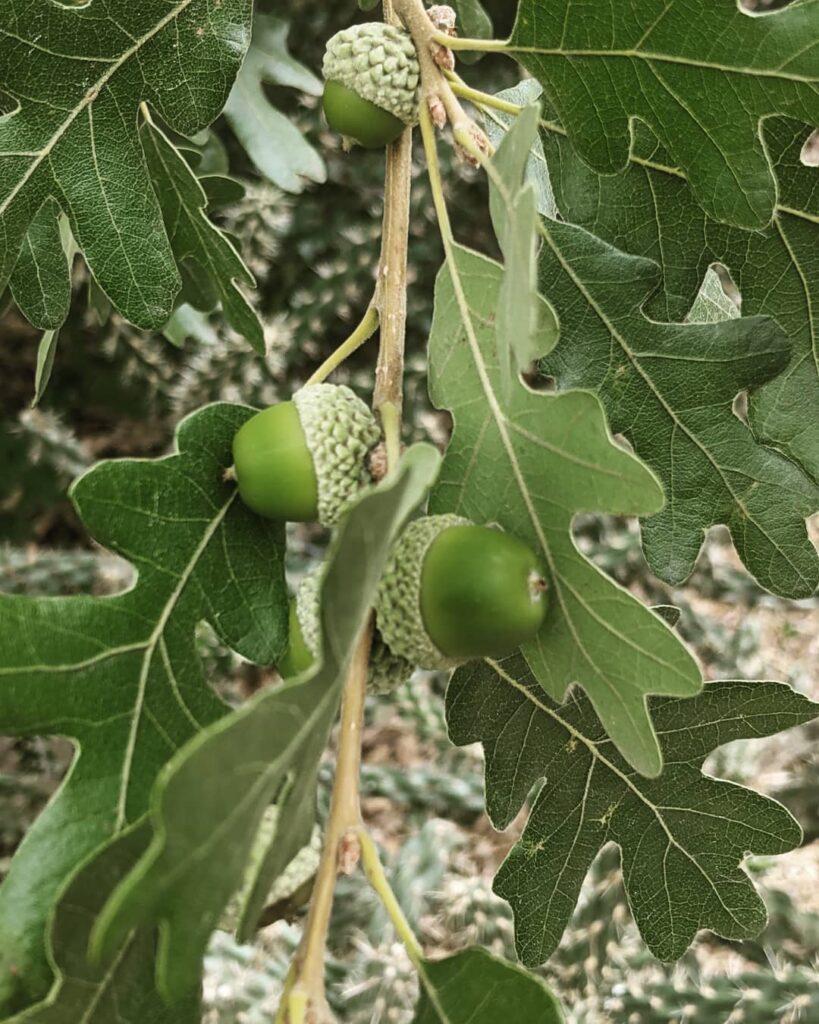
Gambel oak is a versatile native shrub or small tree perfectly suited for western Colorado’s challenging conditions. Growing 20-30 feet tall with an irregular crown, it thrives in rocky, mountainous terrain from 3,000-8,000 feet elevation. This drought-tolerant species provides exceptional wildlife value through its sweetish acorns that feed bears, deer, turkeys, and small mammals, while dense thickets offer essential nesting habitat for birds.
Beyond its wildlife benefits, Gambel oak serves as an excellent landscape plant for low-maintenance gardens. Its deep root system prevents erosion on slopes, and it quickly regenerates after wildfires through root sprouts. The deciduous foliage turns attractive yellow to orange in fall, and the plant can form privacy screens or windbreaks through its natural thicket-forming habit. The Colorado Hairstreak butterfly depends entirely on Gambel oak for its complete life cycle, with larvae that can only survive by consuming the oak’s leaves.
- Hardiness: USDA zones 3-9, extremely tolerant of temperature extremes, high winds, fire, and heavy snow
- Light: Full sun required for ideal growth and health
- Water: Highly drought-tolerant once established; minimal to no supplemental irrigation needed
- Soil: Adaptable to various soil types including thin rocky soils, alkaline conditions, and heavy clay; excellent drainage preferred
- Fertilizer: No fertilization needed; thrives in nutrient-poor native soils
- Pest/Disease Resistance: Highly resistant; well-adapted to local conditions with minimal pest or disease issues
- Growth Rate: Moderate; variable size depending on soil depth and growing conditions
Three-leaf Sumac

Three-leaf Sumac is a hardy, dioecious shrub native to Western Colorado that offers exceptional wildlife value while requiring minimal maintenance. Its compound three-leaflet foliage transforms into brilliant red-orange fall color, while female plants produce nutritious red berries that sustain over 300 bird species through winter months. The multi-stemmed growth habit creates natural thickets that provide shelter for wildlife while serving as effective erosion control on slopes.
This drought-tolerant native thrives in Colorado’s challenging conditions, including alkaline soils, high elevations up to 8,000 feet, and severe deer browsing pressure. Its shallow, spreading root system forms manageable colonies that enhance biodiversity without becoming invasive, making it ideal for sustainable landscape designs that support local ecosystems. For successful berry production, gardeners should plant both male and female plants since this species requires cross-pollination.
- Hardiness: Cold hardy for Western Colorado winters, suitable up to 8,000 feet elevation
- Light: Full sun to partial shade
- Water: Drought-tolerant once established, requires minimal supplemental watering
- Soil: Tolerates alkaline, thin, and poor soil conditions common in Western Colorado
- Fertilizer: None required when properly sited
- Pest/Disease Resistance: Excellent resistance, tolerates pollution and urban conditions
- Growth Rate: Moderate, forms spreading colonies through shallow root systems
Four O’Clock
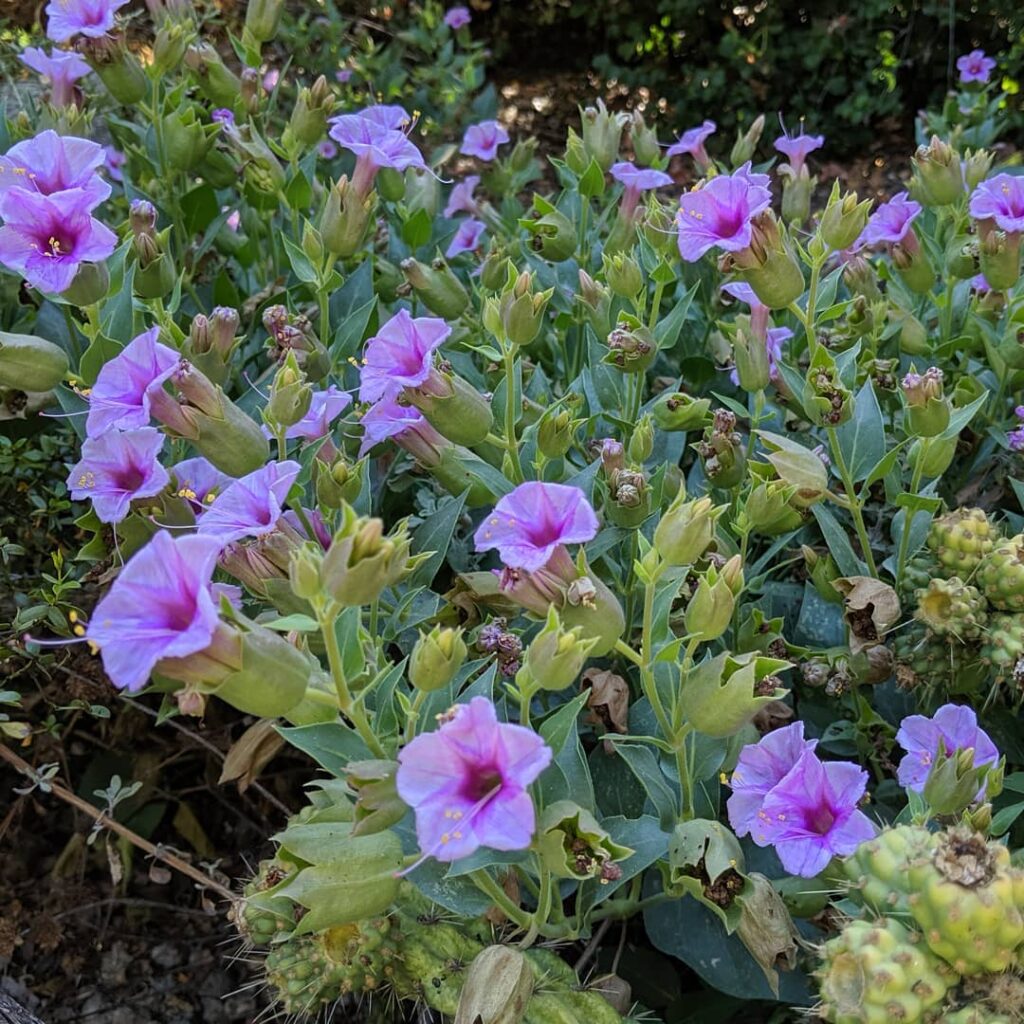
Four O’Clock is a sprawling perennial herb that creates stunning ground cover displays in Western Colorado gardens. This hardy native produces masses of showy pink to magenta funnel-shaped flowers that bloom from April through mid-September, opening in late afternoon and closing by morning. Growing 2-3 feet tall and spreading 3-6 feet wide, it develops an impressive tuberous root system and thrives in juniper and pinyon communities.
The plant serves as an exceptional wildlife supporter, having evolved an exclusive relationship with hawkmoth pollinators. Its evening-blooming habit coincides perfectly with hawkmoth feeding patterns, with each flower producing nectar for just one night to encourage cross-pollination and support genetic diversity in native pollinator populations. The plant also attracts nocturnal insects, hummingbirds, and provides habitat for quail.
- Hardiness: Zones 4-8, native to elevations 2,500-6,500 feet
- Light: Full sun to part shade
- Water: Drought-tolerant once established, minimal water needs
- Soil: Poor, sandy soils preferred; well-draining conditions essential
- Fertilizer: None required; thrives in nutrient-poor native conditions
- Pest/Disease Resistance: Excellent resistance, very few problems
- Growth Rate: Rapid, vigorous summer growth with long-lived perennial habit
Selecting the Right Native Plants for Your Garden
When you’re choosing native plants for your Western Colorado garden, you’ll want to match each species to your specific site conditions rather than simply picking what looks appealing. Smart native plant selection starts with understanding your soil type, elevation, and drainage patterns. Rocky Mountain Juniper works perfectly for rocky outcrops and well-drained slopes, while other species thrive in different conditions.
Consider the five distinct gardening regions across Colorado when making selections. Lower Elevation Western Slope plants differ considerably from foothills species above 7,500 feet. Plants that thrive in this transition zone must adapt to dramatic temperature swings between seasons. This targeted approach reduces garden maintenance and creates healthier, more sustainable landscapes.
Frequently Asked Questions
When Is the Best Time to Plant Native Species in Western Colorado?
You’ll achieve the best results with proper planting techniques during spring or early fall. These seasonal considerations give native species ideal establishment time before Colorado’s extreme weather challenges their root systems.
How Much Do Native Rocky Mountain Plants Typically Cost?
You’ll find native plant pricing ranges from $15-54 for individual specimens, while specialty collections start at $98. When doing cost comparison, larger trees and shrubs typically cost $89-109, with discounts often reducing prices considerably.
Where Can I Purchase Native Plant Seeds in Western Colorado?
You can purchase native plant seeds from specialized native seed vendors like Western Native Seed in Coaldale or Southwest Seed in Dolores, plus local nurseries including Sunscapes and Wild Things.
Do Native Plants Require Special Fertilizers or Soil Amendments?
You’ll find plant nutrition needs are surprisingly modest for natives. They’ve adapted to thrive in unamended native soil conditions. Skip fertilizers and amendments – these well-meaning additions often cause more harm than good.
How Long Do Native Plants Take to Establish in Garden Settings?
You’ll see your native plants become established after their first year in garden settings. Once they’re established, you’ll enjoy dramatically reduced garden maintenance – up to 2400% less time compared to maintaining lawns.
